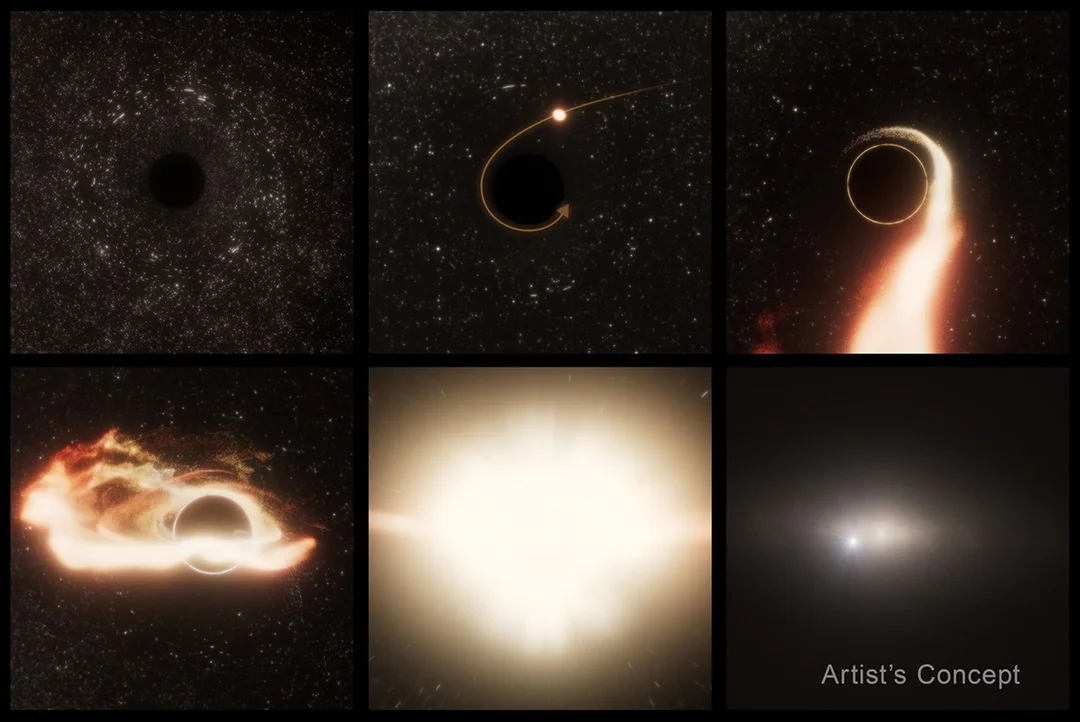
NASA’s Hubble Spots ‘Space Jaws’: A Roaming Black Hole Snacks on a Star
In a cosmic twist worthy of a sci-fi blockbuster, NASA's Hubble Space Telescope has pinpointed a wandering supermassive black hole devouring a star 600 million light-years away. Dubbed "Space Jaws," this rogue black hole isn't where you'd expect it – at the center of its galaxy. This groundbreaking discovery, detailed in an upcoming issue of The Astrophysical Journal Letters, could rewrite our understanding of how galaxies and black holes evolve.
Roaming Black Hole: Unlike most supermassive black holes that reside at the heart of galaxies, this one is a drifter, found 2,600 light-years from the galactic center. Astronomers identified it through a tidal disruption event (TDE), or the event when a star is torn apart as it nears event horizon into a black hole, named AT2024tvd, where a star was "spaghettified" and consumed, creating a spectacular burst of radiation.

A Tale of Two Black Holes: Adding to the intrigue, the galaxy also hosts a central supermassive black hole, 100 million times the mass of our Sun. The smaller, roaming black hole, weighing in at approximately one million solar masses, co-exists within the galaxy but isn't gravitationally bound to its larger counterpart. Could this be a prelude to a future merger? Astronomers speculate that the smaller black hole may eventually spiral inwards, merging with the central behemoth.
Hubble's Sharp Eye: The Hubble Space Telescope's ultraviolet sensitivity was crucial in pinpointing the TDE's precise location, which appeared bluer than the surrounding galaxy. Observations from NASA’s Chandra X-Ray Observatory and the NRAO Very Large Array telescope also confirmed that the black hole is offset from the center of the galaxy. This marks the first time an offset TDE has been optically discovered, opening new avenues for finding other elusive, wandering black holes.
Lead study author Yuhan Yao of the University of California at Berkeley, stated, "AT2024tvd is the first offset TDE captured by optical sky surveys, and it opens up the entire possibility of uncovering this elusive population of wandering black holes with future sky surveys."
How Did It Get There? The black hole's off-center location raises questions. One possibility is that a three-body interaction ejected it from the galactic center. Alternatively, it could be the remnant of a smaller galaxy that merged with the host galaxy long ago. Erica Hammerstein, a UC Berkeley postdoctoral researcher, found no evidence of a past merger, leaving the mystery unsolved.
Implications and Future Research: Ryan Chornock, associate adjunct professor at UC Berkeley, emphasizes the importance of TDEs in revealing hidden black holes: "Tidal disruption events hold great promise for illuminating the presence of massive black holes that we would otherwise not be able to detect." This discovery validates the need for missions like LISA (Laser Interferometer Space Antenna), designed to detect gravitational waves from merging black holes.
The Vera C. Rubin Observatory and NASA’s upcoming Nancy Grace Roman Space Telescope, optimized for capturing transient events, will further enhance these investigations, offering more opportunities for Hubble to zero in on these fleeting phenomena.
What does this discovery mean for our understanding of galactic evolution and the distribution of black holes in the universe? Share your thoughts and theories in the comments below!